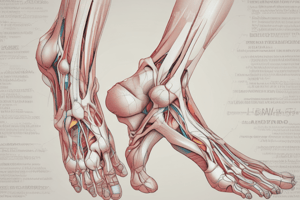Podcast
Questions and Answers
How do the arches in the human foot facilitate upright posture and movement?
How do the arches in the human foot facilitate upright posture and movement?
- By increasing the surface area of the foot, providing a better grip on the ground.
- By storing energy during movement and releasing it for increased propulsion.
- By limiting the foot's flexibility, promoting stability, and reducing the risk of injury.
- By evenly distributing body weight and cushioning the impact of movement. (correct)
If a person experiences pain primarily in the ball of their foot, which structure is most likely affected?
If a person experiences pain primarily in the ball of their foot, which structure is most likely affected?
- The instep.
- The joints connecting the heel bone.
- The arch extending from heel to toes.
- The arch across the ball of the foot. (correct)
A podiatrist is examining a patient with limited foot flexibility. Which anatomical feature is most likely the focus of their assessment?
A podiatrist is examining a patient with limited foot flexibility. Which anatomical feature is most likely the focus of their assessment?
- The condition of the arches.
- The elasticity of the sole.
- The strength of the heel bone.
- The range of motion in the joints. (correct)
An athlete is experiencing significant discomfort during high-impact exercises like running, which part of the foot is not effectively performing its function?
An athlete is experiencing significant discomfort during high-impact exercises like running, which part of the foot is not effectively performing its function?
How would a structural defect in one of the arches of the foot most likely affect a person's gait?
How would a structural defect in one of the arches of the foot most likely affect a person's gait?
Flashcards
Heel
Heel
The back part of the foot.
Instep
Instep
The middle part of the foot, also known as the arch.
Toes
Toes
The front part of the foot containing digits.
Sole
Sole
Signup and view all the flashcards
Ball of Foot
Ball of Foot
Signup and view all the flashcards
Study Notes
- The human foot consists of a heel, instep, and toes.
- The sole is the bottom of the foot.
- The ball of the foot is the part of the sole behind the toes.
- Each foot contains 26 bones.
- The bones create two arches enabling humans to stand and walk upright.
- One arch spans from heel to toes, absorbing the impact of walking.
- Another arch runs across the ball of the foot, distributing body weight.
- Joints allow for easy bending of the foot.
Studying That Suits You
Use AI to generate personalized quizzes and flashcards to suit your learning preferences.



